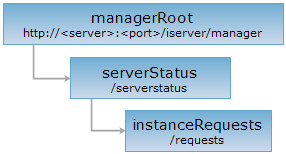
<serverStatus uri>/requests[.<format>]
instanceRequests is service access records query resource, which can be used to view the server access records, including accessed service instances and resource address, visitor user name and client IP, access HTTP method, response code, access time, etc.
Supported Methods:
Supported output formats: RJSON、JSON、HTML、XML.

Implement the HTTP request on the following URI, where supermapiserver is the server name, with rjson being the output format.
http://supermapiserver:8090/iserver/manager/serverstatus/requests.rjson
GET: gets the detailed service access records of the current server.
Implement a GET request for instanceRequests resource, gets the detailed service access records of the current server, the following parameters can be included in URL:
| Name | Type | Description |
| startTime | long | Service access record start time, if it is not positive, it will query from the earliest historical record time which is 00:00:00 GMT, January 1, 1970. |
| endTime | long | Service access record end time, if it is not positive, it will be the current time. |
| expectCount | int | Expected service record number to return, the default is 2000. When expectCount < 0 or expectCount = 0, it means to return all records. |
| userName | String | The corresponding user |
| Field | Type | Description |
| currentCount | int | Returned service access record number. |
| records | InstanceAccessRecord[] | The detailed returned service access records information whose number is currentCount. |
| totalCount | int | The total service access records number |
The returned rjson format resource representation after implementing the GET request on the instanceRequests resource http://localhost:8090/iserver/manager/serverstatus/requests.rjson is as follows:
Asks for the response identical to the one that would correspond to a GET request, but without the response body. This is useful for retrieving meta-information written in response headers, without having to transport the entire content. The meta-information includes the media-type, content-encoding, transfer-encoding, content-length, etc.
HEAD request can be used to check if the instanceRequests resource exists, or if the instanceRequests resource can be accessed by clients. It can also determine if the instanceRequests resource supports an output format <format> if performed on a URI with .<format> included.